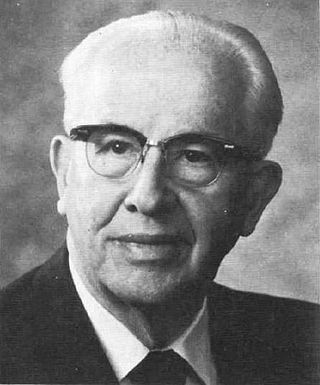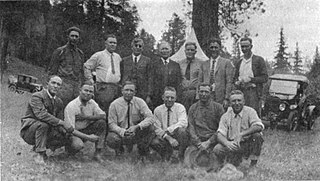Related Research Articles

Brigham Young was an American religious leader and politician. He was the second president of the Church of Jesus Christ of Latter-day Saints from 1847 until his death in 1877. During his time as church president, Young led his followers, the Mormon pioneers, west from Nauvoo, Illinois, to the Salt Lake Valley. He founded Salt Lake City and served as the first governor of the Utah Territory. Young also worked to establish the learning institutions that would later become the University of Utah and Brigham Young University. A polygamist, Young had at least 56 wives and 57 children. He formalized the prohibition of black men attaining priesthood, and led the church in the Utah War against the United States.

The Church of Jesus Christ of Latter-day Saints, informally known as the LDS Church or Mormon Church, is a restorationist, nontrinitarian Christian denomination that is the largest denomination in the Latter Day Saint movement. The church is headquartered in the United States in Salt Lake City, Utah and has established congregations and built temples worldwide. According to the church, it has over 17 million members and over 99,000 volunteer missionaries. The church was the fourth-largest Christian denomination in the United States as of 2012, and reported over 6.8 million US members as of 2023.
The history of the Church of Jesus Christ of Latter-day Saints has three main periods, described generally as:
- the early history during the lifetime of Joseph Smith, which is in common with most Latter Day Saint movement churches;
- the "pioneer era" under the leadership of Brigham Young and his 19th-century successors;
- the modern era beginning in the early 20th century as the practice of polygamy was discontinued and many members sought reintegration into U.S. society.

Mormonism is the theology and religious tradition of the Latter Day Saint movement of Restorationist Christianity started by Joseph Smith in Western New York in the 1820s and 1830s. As a label, Mormonism has been applied to various aspects of the Latter Day Saint movement, although there has been a recent push from the Church of Jesus Christ of Latter-day Saints to distance themselves from this label. A historian, Sydney E. Ahlstrom, wrote in 1982 that, depending on the context, the term Mormonism could refer to “a sect, a mystery cult, a new religion, a church, a people, a nation, or an American subculture; indeed, at different times and places it is all of these."

The Book of Mormon, a work of scripture of the Latter Day Saint movement, describes itself as having a portion originally written in reformed Egyptian characters.

Alfred Emanuel Smith was an American politician who served four terms as the 42nd governor of New York and was the Democratic Party's presidential nominee in 1928.

Ezra Taft Benson was an American farmer, government official, and religious leader who served as the 15th United States secretary of agriculture during both presidential terms of Dwight D. Eisenhower and as the 13th president of the Church of Jesus Christ of Latter-day Saints from 1985 until his death in 1994.

"The Council of Fifty" was a Latter Day Saint organization established by Joseph Smith in 1844 to symbolize and represent a future theocratic or theodemocratic "Kingdom of God" on the earth. Smith prophetically claimed that this Kingdom would be established in preparation for the Millennium and the Second Coming of Jesus.

Joseph Fielding Smith Sr. was an American religious leader who served as the sixth president of the Church of Jesus Christ of Latter-day Saints. He was a nephew to, and the last president of the LDS Church to have known personally, Joseph Smith, the founder of the Latter Day Saint movement.

The Udall family is a U.S. political family rooted in the American West. Its role in politics spans over 100 years and four generations. Udall politicians have been elected from four different states: Arizona, Colorado, New Mexico, and Oregon. If viewed as a combined entity, the Udall-Hunt-Lee family has been elected from six states: Arizona, California, Colorado, New Mexico, Oregon, and Utah.
The succession crisis in the Latter Day Saint movement occurred after the murder of Joseph Smith, the movement's founder, on June 27, 1844.

John Baldwin Neil was an American military officer and politician who served as Governor of Idaho Territory from 1880 to 1883.
Marlin Keith Jensen is an American attorney who has been a general authority of the Church of Jesus Christ of Latter-day Saints since 1989. He served as the official Church Historian and Recorder of the church from 2005 to 2012. He was the 19th man to hold that calling since it was established in 1830. Jensen was made an emeritus general authority in the October 2012 general conference.
The Church of Jesus Christ of Latter-day Saints has been subject to criticism and sometimes discrimination since its inception.

This is a chronology of Mormonism. In the late 1820s, Joseph Smith, founder of the Latter Day Saint movement, announced that an angel had given him a set of golden plates engraved with a chronicle of ancient American peoples, which he had a unique gift to translate. In 1830, he published the resulting narratives as the Book of Mormon and founded the Church of Christ in western New York, claiming it to be a restoration of early Christianity.

The White Horse Prophecy is the popular name of an influential but disputed version of a statement on the future of the Latter Day Saints and the United States. It was given by Edwin Rushton in about 1900, and supposedly made in 1843 by Joseph Smith, Jr., the founder of the Latter Day Saint movement.

Joseph Smith Jr. was an American religious leader and the founder of Mormonism and the Latter Day Saint movement. Publishing the Book of Mormon at the age of 24, Smith attracted tens of thousands of followers by the time of his death fourteen years later. The religion he founded is followed to the present day by millions of global adherents and several churches, the largest of which is the Church of Jesus Christ of Latter-day Saints.

The 1910 New Jersey gubernatorial election was held on November 8, 1910. Democratic nominee and future President Woodrow Wilson defeated Republican Assemblyman Vivian M. Lewis with 53.93% of the vote. During the campaign, Wilson underwent a political transformation from a symbol of conservative Wall Street reaction into one of the leading members of his party's progressive faction. His victory was widely understood to be the prelude to his campaign for the presidency in 1912.

Early in its history, the Church of Jesus Christ of Latter-day Saints had a series of negative encounters with the federal government of the United States. This led to decades of mistrust, armed conflict, and the eventual disincorporation of the church by an act of the United States Congress. The relationship between the church and the government eventually improved, and in recent times LDS Church members have served in leadership positions in Congress and held other important political offices. The LDS Church becomes involved in political matters if it perceives that there is a moral issue at stake and wields considerable influence on a national level with over a dozen members of Congress having membership in the church in the early 2000s, and about 80% of Utah state lawmakers identifying as LDS.

The campaign of Latter Day Saint movement founder Joseph Smith and his vice presidential running mate, Church of Jesus Christ of Latter Day Saints First Presidency first counselor Sidney Rigdon, took place in 1844. The United States presidential election of that year was scheduled for November 1 to December 4, but Smith was killed in Carthage, Illinois, on June 27. Smith was the first Latter Day Saint to seek the presidency, and the first American presidential candidate to be assassinated.
References
- 1 2 Noble Timothy Myers-El (2008). The Unknown Lore of Amexem's Indigenous People: An Aboriginal Treatise. AuthorHouse. p. 84. ISBN 978-1-4343-2767-3.
- ↑ Garr, Arnold K. "Joseph Smith: Campaign for President of the United States". The Church of Jesus Christ of Latter Day Saints. Retrieved 27 July 2017.